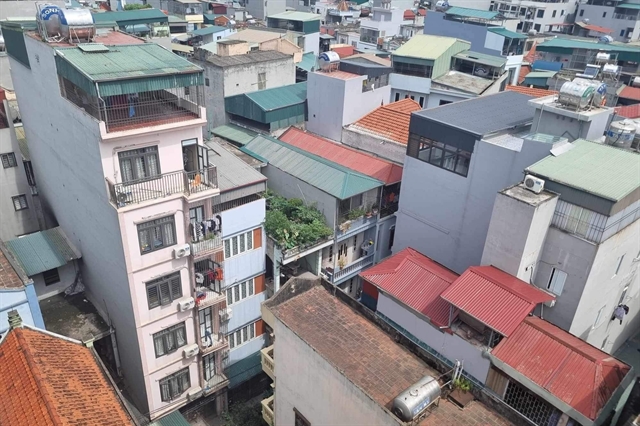 Business Beat
Business Beat

 |
| A customer sells US dollars at a bank in Hà Nội. The USD/VNĐ exchange rate was mostly unchanged in the first seven months of this year though the central bank lowered interest rates four times. — Photo courtesy of diendandoanhnghiep.vn |
HÀ NỘI — Despite the difference in policies of the State Bank of Vietnam (SBV) and the US Federal Reserve (Fed), the USD/VNĐ exchange rate has remained stable to date thanks to a trade surplus and a bright economic outlook of Việt Nam in the second half of 2023, experts said.
According to the Maybank Securities Company (MBKE), there were concerns that the SBV would face big challenges when cutting interest rates drastically while the Fed has still maintained a cautious policy. The contrast in policies between the Fed and the SBV could put pressure on the exchange rate.
However, the concern has not materialised and the USD/VNĐ exchange rate has stayed stable so far. The rate was mostly unchanged in the first seven months of this year after the SBV lowered interest rates four times, totaling from 1.25 percentage points to 1.5 percentage points for discount and refinancing rates. At that time, the Fed tightened the rates four times, raising interest rates by 1 percentage point.
MBKE analysts attributed the stability of the exchange rate to Việt Nam’s trade surplus of US$15 billion in the first seven months of 2023 and a brighter economic outlook in the second half of 2023 and in 2024.
In the short term, the Government is giving more priority to economic recovery. Therefore, MBKE believes the SBV will continue to maintain the loose monetary policy.
Under this context, MBKE suggests a number of measures that the SBV can use to stabilise the exchange rate. First, the central bank should further tighten the control of foreign exchange activities of commercial banks. Secondly, it should tighten a bit of Vietnamese đồng liquidity in the interbank market. Finally, the SBV can sell US dollars from the nation’s foreign exchange reserves to protect the đồng.
According to the analysts, the first measure was usually the first move of the SBV to use when there were unusual fluctuations in the domestic forex market. MBKE noted the SBV has not yet used the remaining two measures in 2023.
The analysts expect the depreciation of about 2-3 per cent of the đồng against the dollar in the next 12 months will not affect the Government's policy stance and the economic recovery.
In addition, MBKE said although rice prices rose to a record level in a decade, inflation should also be under control thanks to a series of favourable factors.
The analysts expect domestic interest rates will drop another 1-1.5 percentage points in the near future, as well as the possibility that the SBV will cut its policy rates by 25 basis points to promote the recovery of the economy.
Shinhan Bank has recently also forecast the SBV will continue to ease its policy to support the economy. However, the bank's analysts warned Việt Nam may need to avoid further cutting interest rates due to weak exports and declining foreign exchange reserves while the country still has poor-performing banks.
In a report released earlier this month, HSBC also said it expects the SBV to deliver another 50 basis point rate cut, the last one in the current easing cycle. Recently, the SBV has also signaled its openness to do more if ‘market conditions allow’.
Shinhan Bank has also forecast that the SBV will continue to ease its policy to support the economy. However, the bank's analysts warned Việt Nam may need to avoid further cutting interest rates due to weak exports and declining foreign exchange reserves while the country still has poor-performing banks.
In the Taking Stock August 2023 report released on August 10, World Bank (WB) also noted as Việt Nam’s credit demand has remained persistently low despite interest rate cuts, further reducing interest rates may not have the desired effect of incentivising credit growth. Also, further interest rate cuts would increase the interest rate differential with global markets, potentially putting pressure on the exchange rate.
Experts believe as the room to reduce the policy interest rates is gradually exhausted, the fiscal policy will support the country’s economic growth in the second half of 2023.
“Fiscal policy support should be accompanied by continued monetary policy accommodation but the space for additional loosening is constrained,” WB noted in the report.
Analysts at Viet Dragon Securities Company (VDSC) also forecast that in the second half of 2023, the fiscal policy will support economic growth. According to VDSC’s analysts, some fiscal policies that will promote growth include: 2 per cent VAT reduction policy (equivalent to VNĐ24 trillion); 20.8 per cent increase in basic salary from July 1, 2023 (equivalent to VNĐ54 trillion); 10-50 per cent reduction for 36 fees and charges for individuals and firms (equivalent to VNĐ700 billion); and the extension of VAT, CIT and land rent policies will continue until the end of 2023.
The SBV last Friday set the daily reference exchange rate at VNĐ23,837 per US dollar, up VNĐ11 from the previous day.
With the current trading band of +/- 5 per cent, the ceiling rate applicable for commercial banks during the day is VNĐ25,027 per dollar and the floor rate VNĐ22,588 per dollar.
Under the same move, commercial banks on the day also increased the rate.
BIDV listed the rate at VNĐ23,593 per dollar for buying and VNĐ23,893 for selling, both up VNĐ8 from the end of August 10.
Meanwhile, Vietcombank kept both buying and selling rates unchanged at VNĐ23,540 for buying and VNĐ23,910 for selling. — VNS




